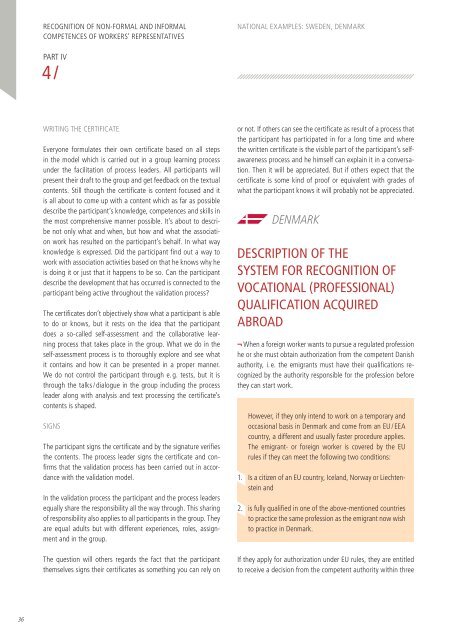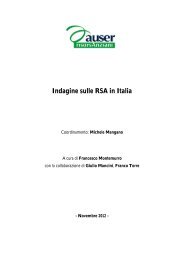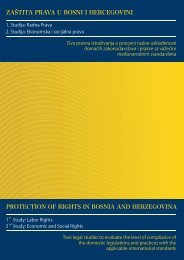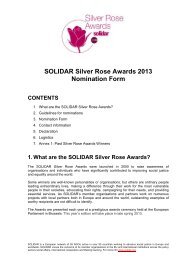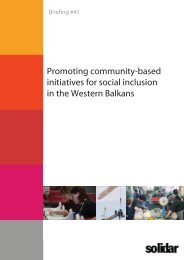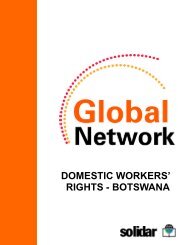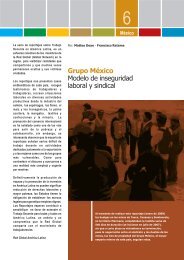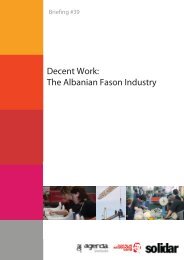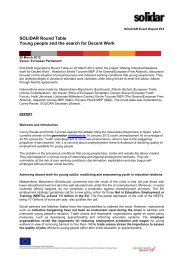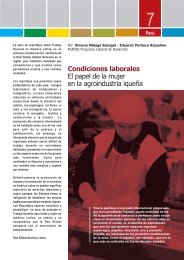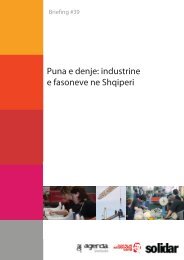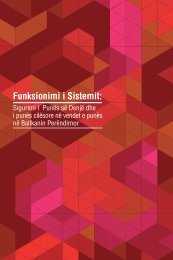RECOGNITION OF NON-FORMAL AND INFORMAL ... - Solidar
RECOGNITION OF NON-FORMAL AND INFORMAL ... - Solidar
RECOGNITION OF NON-FORMAL AND INFORMAL ... - Solidar
You also want an ePaper? Increase the reach of your titles
YUMPU automatically turns print PDFs into web optimized ePapers that Google loves.
<strong>RECOGNITION</strong> <strong>OF</strong> <strong>NON</strong>-<strong>FORMAL</strong> <strong>AND</strong> IN<strong>FORMAL</strong><br />
COMPETENCES <strong>OF</strong> WORKERS’ REPRESENTATIVES<br />
NATIONAL EXAMPLES: SWEDEN, DENMARK<br />
PART IV<br />
4 /<br />
WRITING THE CERTIFICATE<br />
Everyone formulates their own certifi cate based on all steps<br />
in the model which is carried out in a group learning process<br />
under the facilitation of process leaders. All participants will<br />
present their draft to the group and get feedback on the textual<br />
contents. Still though the certifi cate is content focused and it<br />
is all about to come up with a content which as far as possible<br />
describe the participant’s knowledge, competences and skills in<br />
the most comprehensive manner possible. It’s about to describe<br />
not only what and when, but how and what the association<br />
work has resulted on the participant’s behalf. In what way<br />
knowledge is expressed. Did the participant fi nd out a way to<br />
work with association activities based on that he knows why he<br />
is doing it or just that it happens to be so. Can the participant<br />
describe the development that has occurred is connected to the<br />
participant being active throughout the validation process?<br />
The certifi cates don’t objectively show what a participant is able<br />
to do or knows, but it rests on the idea that the participant<br />
does a so-called self-assessment and the collaborative learning<br />
process that takes place in the group. What we do in the<br />
self-assessment process is to thoroughly explore and see what<br />
it contains and how it can be presented in a proper manner.<br />
We do not control the participant through e. g. tests, but it is<br />
through the talks / dialogue in the group including the process<br />
leader along with analysis and text processing the certifi cate’s<br />
contents is shaped.<br />
SIGNS<br />
The participant signs the certifi cate and by the signature verifi es<br />
the contents. The process leader signs the certifi cate and confi<br />
rms that the validation process has been carried out in accordance<br />
with the validation model.<br />
In the validation process the participant and the process leaders<br />
equally share the responsibility all the way through. This sharing<br />
of responsibility also applies to all participants in the group. They<br />
are equal adults but with different experiences, roles, assignment<br />
and in the group.<br />
The question will others regards the fact that the participant<br />
themselves signs their certifi cates as something you can rely on<br />
or not. If others can see the certifi cate as result of a process that<br />
the participant has participated in for a long time and where<br />
the written certifi cate is the visible part of the participant’s selfawareness<br />
process and he himself can explain it in a conversation.<br />
Then it will be appreciated. But if others expect that the<br />
certifi cate is some kind of proof or equivalent with grades of<br />
what the participant knows it will probably not be appreciated.<br />
DENMARK<br />
DESCRIPTION <strong>OF</strong> THE<br />
SYSTEM FOR <strong>RECOGNITION</strong> <strong>OF</strong><br />
VOCATIONAL (PR<strong>OF</strong>ESSIONAL)<br />
QUALIFICATION ACQUIRED<br />
ABROAD<br />
¬ When a foreign worker wants to pursue a regulated profession<br />
he or she must obtain authorization from the competent Danish<br />
authority, i. e. the emigrants must have their qualifi cations recognized<br />
by the authority responsible for the profession before<br />
they can start work.<br />
However, if they only intend to work on a temporary and<br />
occasional basis in Denmark and come from an EU / EEA<br />
country, a different and usually faster procedure applies.<br />
The emigrant- or foreign worker is covered by the EU<br />
rules if they can meet the following two conditions:<br />
1. Is a citizen of an EU country, Iceland, Norway or Liechtenstein<br />
and<br />
2. is fully qualifi ed in one of the above-mentioned countries<br />
to practice the same profession as the emigrant now wish<br />
to practice in Denmark.<br />
If they apply for authorization under EU rules, they are entitled<br />
to receive a decision from the competent authority within three<br />
36


